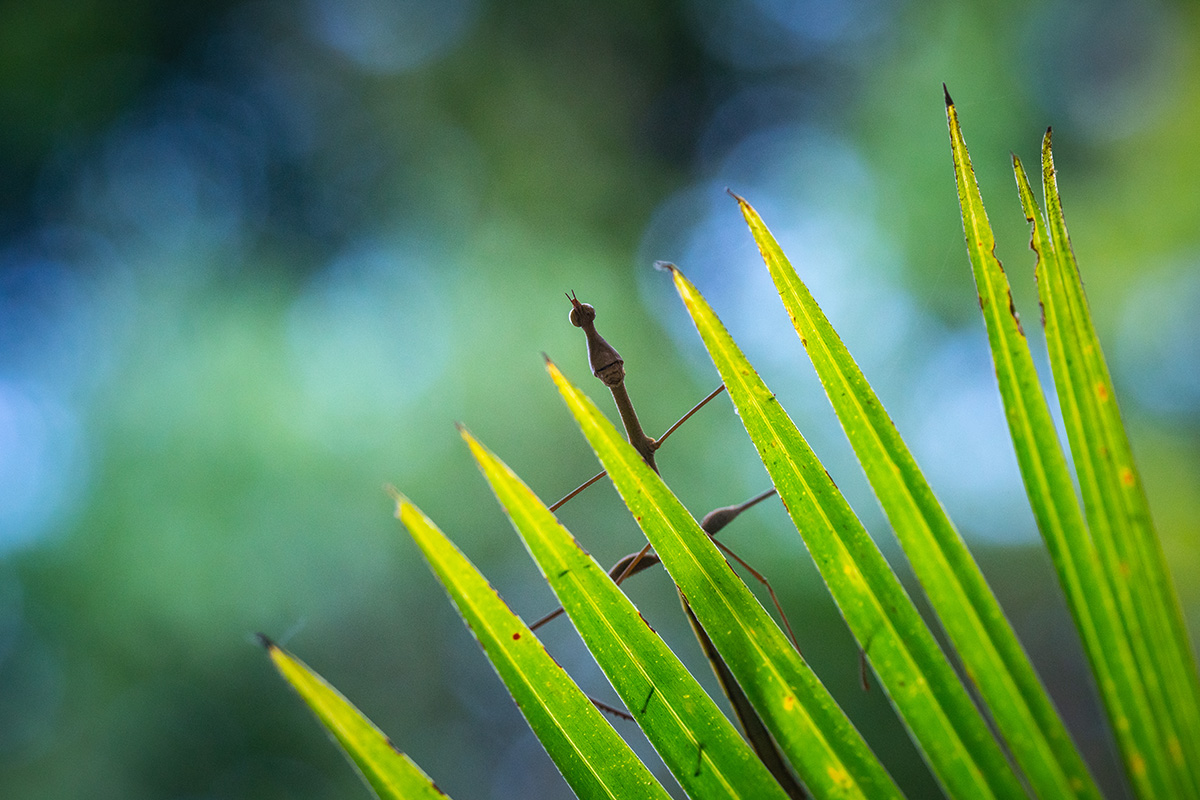Peru’s Close-Up
With his Tamron 50-400mm VC ultra-telephoto zoom, Paul Winner documents the jungle dwellers most people would pass right by.
Share the article:
More Photo Tips | Video Gallery | Photo Gallery | Enewsletter sign-up
By Jenn Gidman
Images by Paul Winner
When Paul Winner traveled deep into the Peruvian jungle in 2021 for an ethnomedical retreat at the Temple of the Way of Light, located in Iquitos, his Tamron 17-28 helped him capture all of the ins and outs of the spiritual ritual. When he was invited back last year, he knew he wanted to focus on something else photographically: the myriad insects, creatures, and plants he’d spotted in this remote part of the Amazon the first time around.
For this trip, Paul test-drove the Tamron 50-400mm Di III VC VXD ultra-telephoto zoom on his Sony mirrorless camera system, his curiosity piqued by the 50-400’s close-up shooting capabilities. Users can achieve half-macro photos with a 1:2 magnification ratio at the wider end of the lens (50mm-70mm), with a Minimum Object Distance, or MOD, of 9.8 inches at 50mm and 10.6 inches at 70mm. When going full telephoto, the MOD is 59.1 inches, with a maximum magnification ratio of 1:4.
“I admit I had reservations using an ultra-telephoto for this kind of close-up work,” Paul says. “Once I got to the retreat, however, I fell in love with the 50-400mm. I couldn’t believe how well it handled in low-light conditions—the jungle’s canopy is quite thick. Plus, I was handholding much of the time, so the Vibration Compensation (VC) feature came in very handy to eliminate any camera shake. The image quality was spectacular, and it’s relatively compact and lightweight.”
What Paul most appreciated about the 50-400mm is how it helped him see the Peruvian jungle in a new light. “Typically, when I pass a tiny bug in my travels, I won’t stop to take a photo of it,” he says. “But this lens made me more aware of those smaller subjects, because now I’m able to take gorgeous photos of them.”
PAUL’S QUICK TIPS
Break out the bokeh.
When I photographed that teensy fly on the end of the branch, I wasn’t sure how well this lens would be able to focus on something that was a mere quarter-inch long, or what kind of bokeh I could get shooting at F6.3 or F7.1. As you can see here, the falloff is fantastic. It offers stellar sharpness of my subject, but with enough falloff so that there’s strong separation and depth.

50-400mm (400mm), F7.1, 1/400 sec., ISO 6400
Click image to view larger
My favorite image showing the capability of the 50-400mm in this regard is of the insect with the iridescent wings on that multicolored leaf. You’re better able to tell here how effective the falloff is, because it’s a more spatially “cluttered” scene. This lens allows me to show depth, which helps the viewer feel more immersed in the visual. Being able to see those details in the wings and the bug’s barbed feet speak to the sharpness of the lens as well.

50-400mm (400mm), F6.3, 1/250 sec., ISO 1000
Click image to view larger
Look for colors and textures that pop.
I was focused on the texture of the aloe vera plant you see here when I spotted a jumping spider hanging out on it. It’s small enough in real life that it would fit on a dime. It was its vibrant markings that caught my eye, standing out beautifully from the backlit green of the plant. The same with the Urodid moth cocoon, which was the size of a jelly bean. It was so tiny, but the color jumped out at me as I was walking down a jungle path.

50-400mm (145mm), F6.3, 1/320 sec., ISO 2000
Click image to view larger

50-400mm (400mm), F6.3, 1/160 sec., ISO 12800
Click image to view larger
The mushroom on the jungle floor was a texture shot for me. I was drawn into its stunning geometric pattern. I wasn’t sure how this photo would turn out, because it was so dark in the jungle, but as you can see, the 50-400mm did its job, and then some.

50-400mm (161mm), F6.3, 1/80 sec., ISO 6400
Click image to view larger
Approach insect and animal portraits as you would a human’s.
When we come face to face with another species, we often seek some familiarity. My partner’s son is 8, and we’ve had discussions about anthropomorphic features. I tried to capture that feeling with this image of a napping sloth, nestled into the bushy part of the base of a tree. I filled the frame a bit to get a more up-close look and capture its vulnerability.

50-400mm (342mm), F6.3, 1/250 sec., ISO 12800
Click image to view larger
Then there’s the photo I call “A Bug’s Life,” showing a stick bug peering out from the plant it was on. I photographed the bug from a variety of different perspectives, but by shooting from this particular angle, I was able to offer a nice glimpse of its almost human-like face as it stared down at me. It shows a bit of curiosity you might not expect from insect subjects.

50-400mm (145mm), F6.3, 1/320 sec., ISO 2000
Click image to view larger
To see more of Paul Winner’s work, go to https://thepaulwinner.com or check out his Instagram.
More Photo Tips | Watch Videos | Learn More About Tamron Lenses | Photo Gallery
